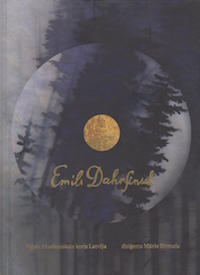Odradek Records, a classical and jazz musical label founded in 2012, considers itself a “democratic, non-profit, artist controlled cooperative label” that determines what to release based on the process of “democratically evaluating anonymously submitted demos”. As a result, the selections released by the label are an eclectic group, and the label has also turned its attention to Latvian artists and compositions.
The first such release focusing on Latvian artists is 2015’s Kurland Sounds, collecting symphonic works by three Latvian composers who originally hailed from the Kurzeme area of Latvia – Vilnis Šmīdbergs, Ēriks Ešenvalds, and Pēteris Vasks. All the works are, appropriately, performed by an orchestra from the Kurzeme region – the Liepāja Symphony Orchestra, conducted by Atvars Lakstīgala. The city has nearly a century and a half of history with symphonic music — the first Baltic symphony orchestra was founded in 1881 in Liepāja.
The first work presented on the CD is composer Vilnis Šmīdbergs’ “Merry-Go-Round” for symphony orchestra. Šmīdbergs, originally from Ventspils, though musical for his entire life, only became a full-fledged composer later in life, though he did dabble in art rock in the 1960s with the group Katedrāle and initial forays into composition with smaller scale chamber and symphonic works in the 1970s/1980s. Now, in the 21st century, Šmīdbergs is an active composer, and his music is described as “harsh and sometimes stinging” but “refreshing”. “Merry-Go-Round” is such a work – presenting the titular carnival ride as a wheel of life, reflecting many different emotions, but with the tragic undertone that we only go in circles – humanity still continues to repeat the same mistakes in terms of war and destruction. In fact, though the merry-go-round is a children’s ride, it can turn into something quite frightful – the work may remind listeners of the out-of-control carousel in the climax of Alfred Hitchcock’s film “Strangers on a Train”. Šmīdbergs presents a vision that is at once humorous and terrifying.
Ēriks Ešenvalds, originally from Priekule, though perhaps best known for his choir works, is also an adept composer of symphonic music. His contribution to this collection is the 4th Liepāja concerto “Visions of Arctic: Night”. Many of Ešenvalds’ works have been inspired by the Northern Lights, and, as per the composer himself, this work includes both elements from Kurzeme and from the Arctic. The clarinet is performed by renowned Latvian clarinetist (and former Latvian Minister of Culture) Ints Dālderis. The windy city of Liepāja and the remote yet beautiful area above the Arctic Circle are presented in dreamy, thoughtful musical language – the first movement concludes with a quiet and light wind symbolizing the city. The second movement presents a picture of the Arctic, though cold and desolate, a place of great wonder and beauty. The third and final movement, a dramatic and stormy journey, brings this journey to a close, with Dalderis bringing the right amount of mystery and wonderment to this expansive landscape. The work is labeled as the “4th Liepāja concerto” as there is an ongoing effort to compose and record twelve concertos by different composers on the theme of the city of Liepāja (and Odradek Records has committed to release all of them when ready).
The album concludes with Pēteris Vasks’ (originally from Aizpute) monumental Symphony No. 2. From its dramatic opening, the work also displays themes of Latvian nature and imagery. Much of Vasks’ music is full of foreboding, about the fragility of life and Latvian flora and fauna, but still some glimmers and rays of hope that it is not too late to preserve all that has been created. The middle section of the symphony, which seems to present a musical view of dawn in the forest, with birds chirping and streams flowing, is a particularly engrossing performance, which then rapidly increases in dramatic tension as the landscape comes under threat. The Liepāja Symphony Orchestra proves to be an exceptional interpreter of this large-scale work, being at once dramatic and reserved, and presents a compelling performance of Vasks’ vivid vision.
The CD booklet has extensive notes on the composers, the works, and the performers in English, German and Latvian, as well as pictures of all of the orchestra members.
Kurland Sounds is a remarkable achievement by the Liepāja Symphony Orchestra and conductor Atvars Lakstīgala. Providing memorable performances of these disparate works, the Orchestra shows its versatility and flexibility. Odradek Records is to be thanked and praised for ensuring that these performances are available for a larger audience, as these composers from Kurzeme confirm that the music of Latvian composers, in the hands of such talented musicians as the Liepāja Symphony Orchestra and Atvars Lakstīgala, is unparalleled in its beauty and creativity.
For further information, please visit the Odradek Records website at and the Liepāja Symphony Orchestra website.
Kurland Sounds
Liepāja Symphony Orchestra
Odradek, ODRCD319, 2015
Track listing:
- Merry-Go-Round – Vilnis Šmīdbergs
- 4th Liepāja concerto “Visions of Arctic: Night” – Ēriks Ešenvalds – Part I
- Part II
- Part III
- Symphony No. 2 – Pēteris Vasks






